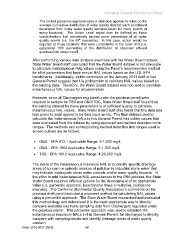Page 142 - California Stormwater Workshop Handouts
P. 142
Industrial General Permit Fact Sheet
The ranked percentile approach (also a statistical approach) relies on the
average cumulative distribution of water quality data for each constituent
developed from many water quality samples taken for many events at
many locations. The Action Level would then be defined as those
concentrations that consistently exceed some percentage of all water
quality events (i.e. the 90th percentile). In this case, action would be
required at those locations that were consistently in the outer limit (i.e.
uppermost 10th percentile) of the distribution of observed effluent
qualities from urban runoff.
After performing various data analysis exercises with the Water Board dataset,
State Water Board staff concluded that the Water Board dataset is not adequate
to calculate instantaneous NAL values using the Panel’s recommended method
for all of parameters that have annual NAL values based on the U.S. EPA
benchmarks. Additionally, public comments on the January 2011 draft of this
General Permit suggest that it is problematic to calculate NAL values based on
the existing data. Therefore, the Water Board dataset was not used to calculate
instantaneous NAL values for all parameters.
However, since all Dischargers regulated under the previous permit were
required to sample for TSS and O&G/TOC, State Water Board staff found that
the existing dataset for these parameters is of sufficient quality to calculate
instantaneous NAL values. State Water Board staff also found that this data was
less prone to what appear to be data input errors. The final dataset used to
calculate the instantaneous NALs in this General Permit had outlier values that
were eliminated from the dataset by using approved test method detection limits
ranges. The methods and corresponding method detection limit ranges used to
screen outliers are as follows:
O&G - EPA 413.1 Applicable Range: 5-1,000 mg/L
O&G - EPA 1664 Applicable Range: 5-1,000 mg/L
TSS - EPA 160.2 Applicable Range: 4-20,000 mg/L
The intent of the instantaneous maximum NAL is to identify specific drainage
areas of concern or episodic sources of pollution in industrial storm water that
may indicate inadequate storm water controls and/or water quality impacts. In
the effort to add instantaneous NAL exceedances to the ERA process, the State
Water Board explored different options for the development of an appropriate
value (i.e. percentile approach, benchmarks times a multiplier, confidence
intervals). The California Stormwater Quality Association’s comments on the
previous draft permit included a proposed method for calculating NAL values
using a percentile approach. The State Water Board researched and evaluated
this methodology and determined it is the most appropriate way to directly
compare available electronic sampling data from Dischargers regulated under
the previous permit. This percentile approach was used to establish the
instantaneous maximum NALs in this General Permit, for discharges to directly
compare with sampling results and identify drainage areas of water quality
concern.
Order 2014-0057-DWQ 58

